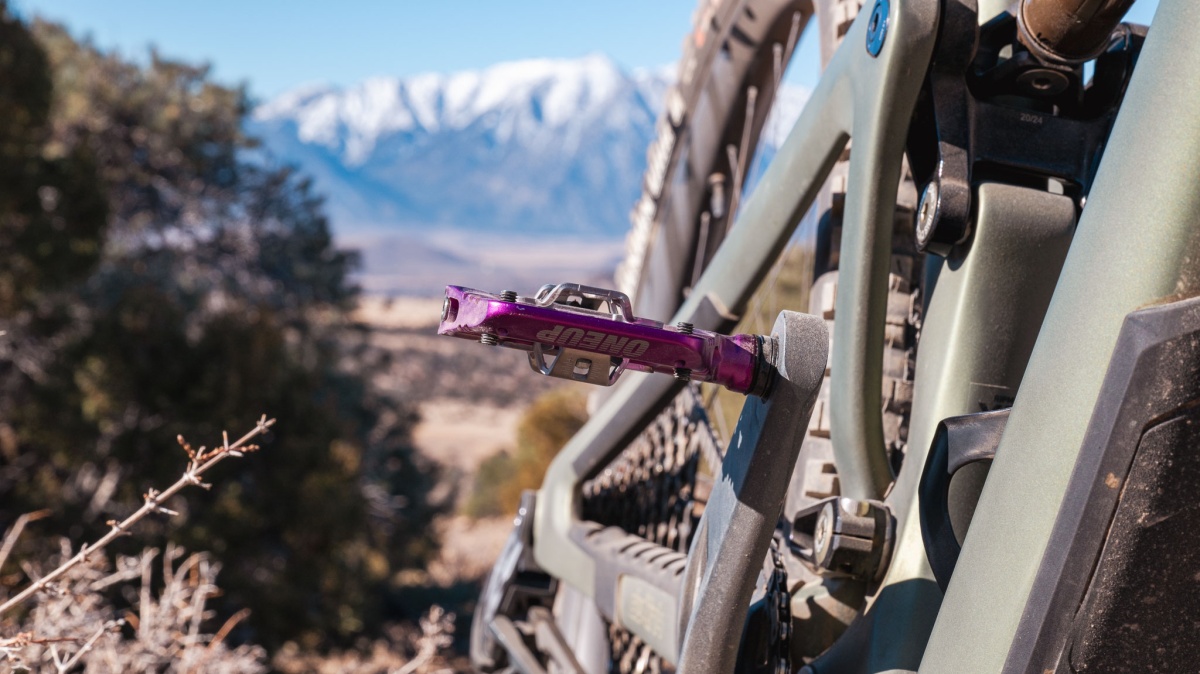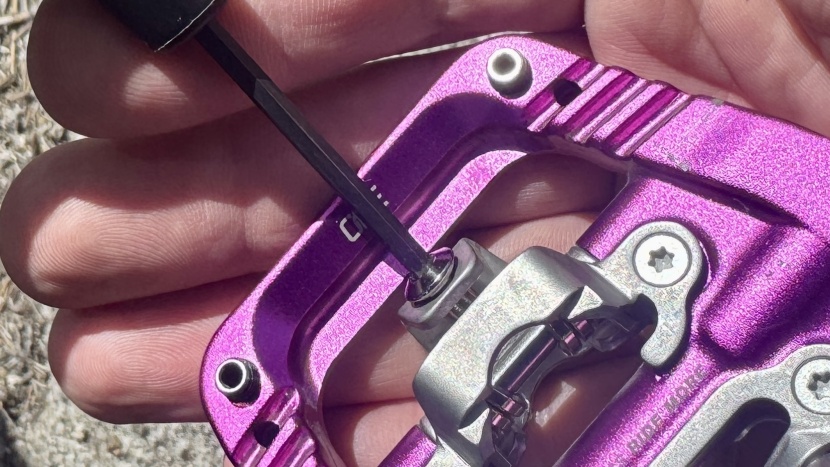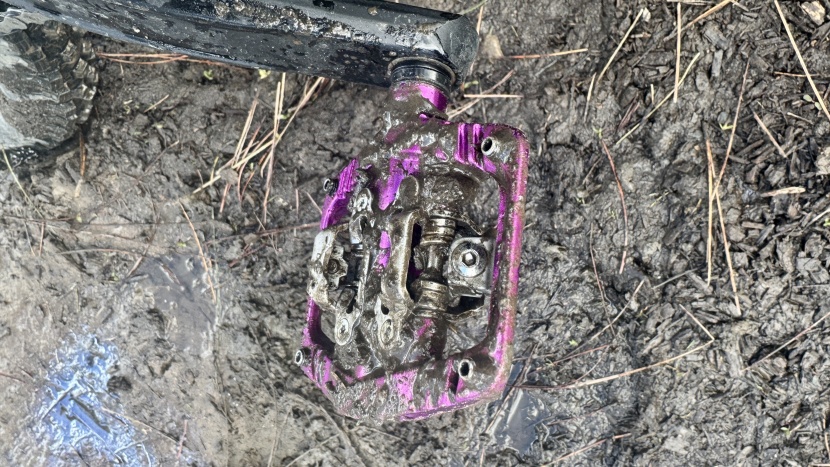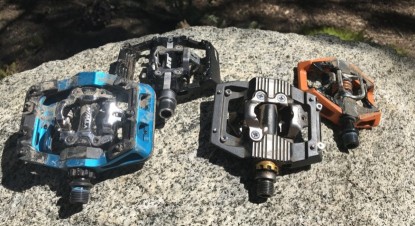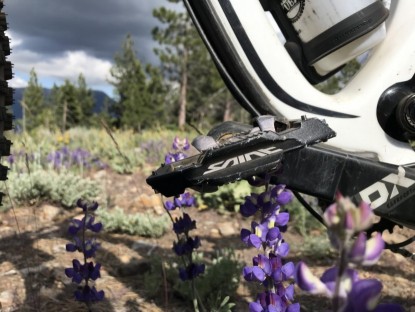Our Verdict
Compare to Similar Products
 This Product
OneUp Clip pedals | |||||
|---|---|---|---|---|---|
| Awards | Best Overall Mountain Bike Pedal | An excellent lightweight option | Another Great Trail Riding Pedal | Best Bang for the Buck | Best for Enduro and Downhill Riding |
| Price | $160 List | $146.76 at Amazon Compare at 3 sellers | $106.74 at Amazon Compare at 4 sellers | $52.48 at Amazon Compare at 4 sellers | $149.99 at Amazon Compare at 2 sellers |
Overall Score  |
|||||
| Star Rating | |||||
| Bottom Line | An excellent platform for aggressive trail riders looking for connection and tunability | Stable platform, highly adjustable, and available in a multitude of colors | Shimano's latest enduro approved pedal grows up a bit and the refreshes are mostly welcome | A solid choice for those wanting next generation stability at an entry-level price point | Solid, stable and heavy, we found the control they offer top-notch |
| Rating Categories | OneUp Clip pedals | HT Components T2 | Shimano PD-M8120 XT... | Shimano ME700 | Shimano Saint SPD M820 |
| Ease of Exit (25%) | |||||
| Ease of Entry (20%) | |||||
| Adjustability (20%) | |||||
| Weight (15%) | |||||
| Platform (10%) | |||||
| Mud Shedding Ability (10%) | |||||
| Specifications | OneUp Clip pedals | HT Components T2 | Shimano PD-M8120 XT... | Shimano ME700 | Shimano Saint SPD M820 |
| Weight per Pair (grams) | 414g | 380g | 430g | 482g | 550g |
| Weight of Cleats and Bolts (grams) | 52g | 62g | 51g | 50g | 50g |
| Cleat Type | SPD mountain | HT X1 cleats | SPD mountain | SPD mountain | SPD mountain |
| Style | mini-cage | mini-cage | mini-cage | mini-cage | mini-cage |
| Platform Dimensions (lxw) | 90 x 80mm | 83.5 x 68mm | 100 x 71mm | 100 x 74mm | 100 x 79mm |
| profile height | 14.4mm | 17mm | 18mm | 19mm | 19mm |
| Stance | 57mm | 56mm | 55mm | 55mm | 57mm |
| Total Width from Crank Arm | 97.5mm | 90mm | 92mm | 93mm | 95mm |
| Entry | 2-sided | 2-sided | 2-sided | 2-sided | 2-sided |
| Adjustable Tension | yes | yes | yes | yes | yes |
| Traction Pins | 4/side | 4/side | 0 | 0 | 4/side |
| Bearings | 3 Sealed Cartridge and Igus bushing | Stainless Steel sealed cartridge bearings | dual angular contact, metal retainer | dual angular contact, plastic retainer | dual angular contact, metal retainer |
| Cage Material | forged / machined aluminum | extruded/CNC machined aluminum | anodized and machined aluminum | painted aluminum | forged and machined aluminum |
| Pedal Wrench Type | 8mm allen | 8mm allen | 8mm allen | 6mm allen or 15mm open end | 8mm allen |
Our Analysis and Test Results
The OneUp Clip Pedal is an aptly named ultra-thin mid-cage pedal that finally offers something better for aggressive riding than the venerable XT. The Clip pedal not only fixes the naming convention of “clipless” but also solves a few issues that Shimano never addressed with this style of pedal. With a stack height that is 2.6mm thinner than XTR and 3.6mm less than XT, these low-profile pedals feature four traction pins on each side that actually interface with your shoe. The retention mechanism was designed from the ground up using stainless steel to provide a more solid and adjustable riding experience than SPD. The pedals feature an easy-to-read tension indicator, so you don't have to turn all of your adjustments in one direction and count detents anymore. We got off to a rough start with the clip pedal as, just two weeks into testing, they were recalled to fix an issue with the original binding plate.
Not only are these the thinnest profile pedals we have tested, but OneUp's forged and machined aluminum bodies boast an 80mm wide surface that measures 95mm long. The pedals are fully SPD compatible, so you don't need to have separate shoes or replace all of the pedals in your fleet to ride them. With 5 degrees of float and a 12-degree release angle, they're not breaking the mold and don't feel like an entirely new system. The chromoly steel axles are supported by an inboard IGUS bushing and three outboard sealed bearings. The pedals are user-serviceable and include a bearing nut tool, allowing you to keep them clean and lubed. To sum it up, they're lighter than XT, thinner than XTR, user serviceable, have a more solid feel, include traction pins, and, oh- they're available in seven colors.
I loved these pedals from the moment I opened the box. They're incredibly thin with accurate machining and vibrant anodization. The hollow traction pins allow you to adjust or extract pins from either side of the pedal, which is a relief; anyone who has tried to extract a damaged pin can empathize. The retention mechanism adjusts in the same fashion as a typical SPD but allows you to see a visual indicator of just how high the tension is. In their lowest tension setting, the release is approximately the same as the lightest setting on a Shimano pedal, but in the highest setting, they're vice grip tight. I sometimes ride my XT pedals in the highest tension setting, especially when they're wet, and I'm riding high-consequence lines. I found the high-tension setting on the OneUp to be significantly tighter.
Ease of Entry
Getting into the Clip Pedal requires the same basic movement as any other “clipless” pedal. In the lightest tension setting, the pedals require very little effort to engage, and depending on the outsole of your shoe, you may or may not get some resistance from the traction pins. A similar dynamic exists when the pedals are adjusted to higher tension, with the retention mechanism providing more resistance to entry. They're never exactly hard to get into, but they don't have that “fall into place” feeling you experience with the fluorine-coated XTR pedals. The trade-off is an incredibly secure feeling that has no play outside of your float.
Tuning the pins for each shoe helps to minimize entry resistance while maximizing the grip and platform feel. This is the case with most mini-cage pedals but results in much more of a platform feel with the OneUps. The engagement changed little when the pedals were wet or muddy, allowing quick, positive engagement with a simple downward force. I removed the pins, and they still weren't as easy to drop into as an SPD, but after riding them for a couple of months, I'm not sure how much this matters on the trail. In a race situation, I absolutely want the fastest and easiest engagement possible, but that feels less important when I'm out chasing single-track.
Ease of Exit
The OneUp Clip provides consistent release in wet or dry. As the spring tension can be cranked up much higher than on Shimano or HT pedals, the ease of exit could be much harder. Conversely, they can be tuned to a light setting and be easy to release from. The same heel swing you're used to with other pedals breaks you free of the retention system at 12 degrees, regardless of the set tension. The pedals produce a positive snap that lets you know you're disengaged; there is no vague or inconsistent feeling like you might experience on a Mallet or Double Shot.
The release doesn't feel significantly different from an XT pedal, save for the release tension. Most of the shoes I used with these pedals had contact with the traction pins, and you occasionally feel the pins dig in toward the edge of your exit angle. I was able to tune the pins to have contact while the shoe flexed. The friction between the sole of the shoe and the stainless hardware wasn't affected much by water or mud, but moving the pins up and down significantly affected the feel of the float.
Adjustability
With release tension adjustable far beyond what we've experienced with SPD pedals, the Clip pedal already feels more customizable for the user. Adjusting the hollow traction pins from both sides of the pedal allowed me to fine-tune the pin height with the shoe engaged easily. This shouldn't seem groundbreaking in 2025, but it is. Instead of incrementally unclipping and dialing the pin height, I could slip out of the shoe and make adjustments from the opposite side of the pedal.
Changing the release tension is the same as other SPD pedals using a 3mm Allen key; you make adjustments to each side of each pedal independently. Unlike the SPD adjustment, a small window in the binding allows you to see where the binding tension nut is, ensuring even adjustment. I love that these pedals use the SPD cleat for convenience. I usually have about a dozen bikes, and introducing a new pedal eco-system inevitably leads to showing up at the trailhead with the wrong shoes and having to swap cleats. SPD cleats are also widely available; you can find the SH51 and SH56 cleats at almost every bike shop in America, while hunting down Hope or HT cleats can be a bit more difficult.
The traction pins are independently adjustable, meaning that lowering them on one side of the pedal doesn't raise them on the other. The pedals are also fully functional with the traction pins removed and still provide a solid platform underfoot.
Weight
Tipping our scales at 413.9 grams, the OneUp Clip pedals are only 17 grams above the Shimano XTR M9120. It's a good spot to reiterate that these pedals use a forged body like the Look X-Track En-rage or Shimano Saint clipless pedals. This gives the body unrivaled durability, and that's likely even more important given the Clip's 14.4mm stack height. At the time of this review, no titanium axles are available, nor is there any way to reduce the pedal's weight. That said, these pedals do not have a weight limit.
Weight-weenies that want in on this action could shave about 20 grams by switching to 3D-printed titanium cleats. They are not a cost-effective gram reduction, but I love that they don't rust. The OneUp cleats weighed 52 grams on our scale, with Shimano cleats weighing in at 51 grams, both with hardware.
Platform
The usable part of the platform on the Clip Pedal measures 80mm x 90mm, with the overall length being 95mm due to the forward-leaning angle. This platform rivals the Shimano Saint M820 for its stability and excellent power transfer. What I find even more remarkable is how low-profile the pedals are. This platform feels substantial, but your chance of pedal strikes is lower than any other clipless mini-cage style pedal we've tested. We fielded some trailhead questions about the pedals, and despite having four pins on each side, you don't want to pedal them with flat shoes. The pins increase your engagement with the pedal and help you orient it for entry.
Most of the shoes I used to test these pedals also interfaced with the area next to the spindle, which is not officially part of the platform but does provide extra lateral stability. The Hope Union TC pedal has a similar design, and that small amount of extra surface next to the arch of your foot contributes not only to the extra support you feel but also to increased support for the IGUS bushing and three sealed cartridge bearings.
Mud Shedding
We subjected the pedals to a bevy of clogging material throughout our testing. We focus on their ability to clear mud, but snow and sticky clay are also commonly found in our testing terrain. The Clip pedals never presented an issue with clogging. Even in contrived moments where we sat and purposefully loaded the cleat beds of our shoes full of sticky mud, we could still find engagement without much trouble.
The Clips work well in mud, snow, and loose debris, but their mud-shedding abilities aren't as good as the venerable Shimano XTR with their slick coating. We were never unable to clip in, but there were times when the amount of mud underfoot made the process more difficult. Because the Clip pedals give more interface with your shoe, mud on your sole can complicate entry more so than mud surrounding your celat.
Should you buy the OneUp Clip pedals?
Do you want a favorite new pedal? The Clips are incredibly low profile, highly adjustable, relatively lightweight, and come in seven cool colors. Why wouldn't you buy these? If we had to talk you out of them, we could remind you that they cost $160, and that's more than the Shimano XT M8120, or that they only have a one-year warranty vs. the three-year warranty that Shimano has. We can attest that the Shimano pedals are incredibly durable and last, well.. long enough for Shimano to come out with new pedals? Ouch. After just a couple of months of riding on the Clip Pedals, we can't make any claims about their durability. Still, their feel and performance are enough that we'll take our chances and update this review if we have any complications.
What Other Mountain Bike Pedals Should You Consider?
Our two other favorite pedals of this style are the Shimano XT M8120 and the HT T-2. Both are excellent in their own right, but we're pretty fired up about the thickness and feel of the OneUp Clips. If having SPD-compatible cleats isn't important to you, I also really liked the Hope Union TC Pedal


